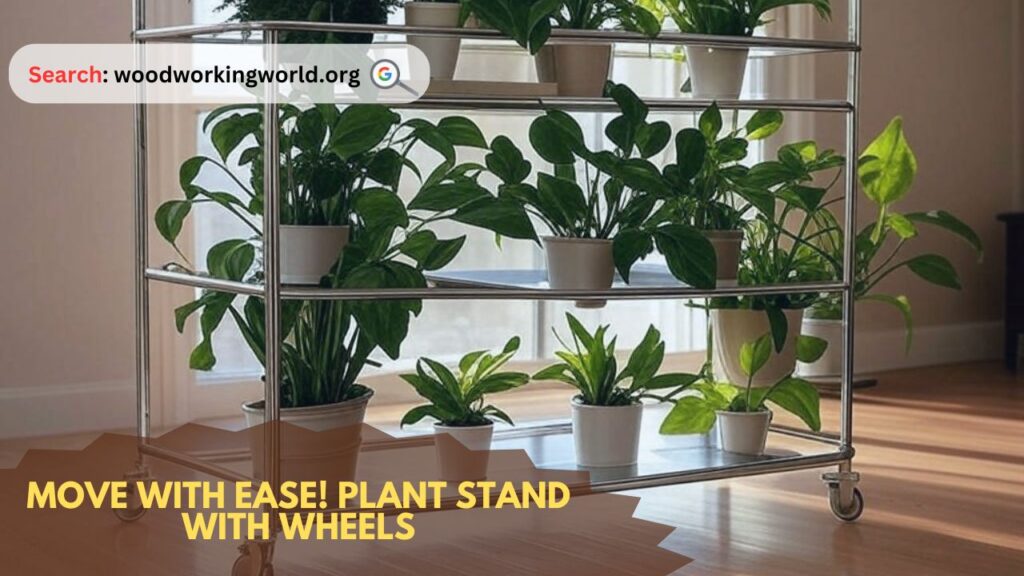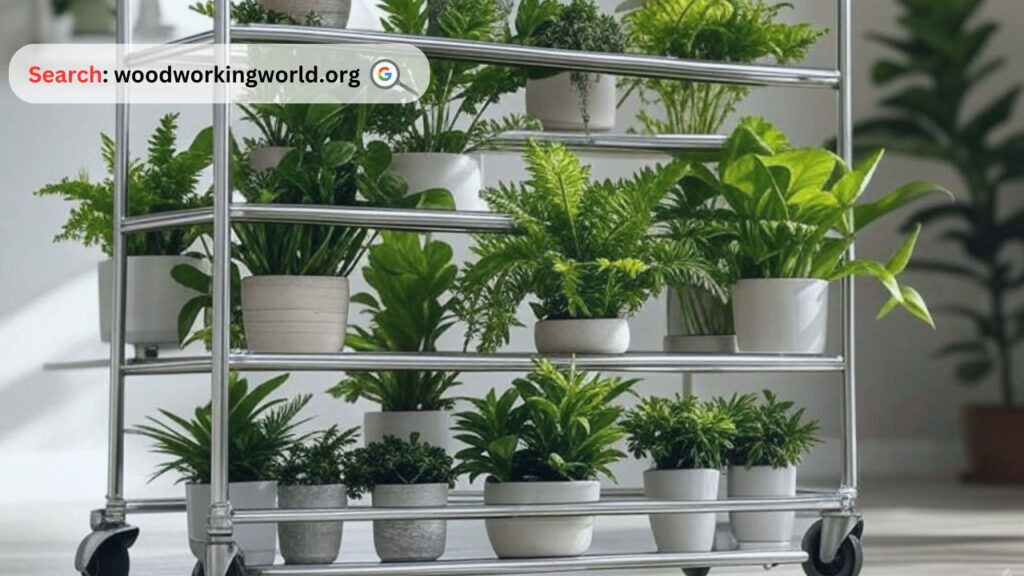Move heavy plants effortlessly with a plant stand with wheels! Perfect for indoors or outdoors, it adds style and convenience while protecting your floors.
If you love gardening and decorating your home with plants, you know how frustrating it can be to move heavy pots around. Whether you’re rearranging your space, cleaning, or ensuring your plants get the best sunlight, a plant stand with wheels can be a game-changer. Not only does it add convenience, but it also protects your floors from scratches and helps keep your indoor and outdoor areas tidy.

In this in-depth guide, we’ll explore everything you need to know about plant stands with wheels, including their benefits, materials, a step-by-step guide to making your own, a comparison of different options, and frequently asked questions.
Benefits of a Plant Stand with Wheels
Before we dive into the DIY process, let’s look at some of the key benefits of using a plant stand with wheels:
✅ Easy Mobility: Move heavy plants effortlessly without straining your back.
✅ Protects Your Floors: Avoid scratches and damage caused by dragging pots.
✅ Improves Sunlight Access: Easily reposition plants for better sunlight exposure.
✅ Enhances Air Circulation: Prevents mold and pests by elevating plants off the ground.
✅ Ideal for Indoor & Outdoor Use: Works well on patios, balconies, or inside homes.
Build 16,000+ Projects with Step-by-Step Plans—No Big Workshop or Costly Tools Needed! Start Now!
How to Make a DIY Plant Stand with Wheels (Step-by-Step)
If you enjoy woodworking and DIY projects, making your own plant stand with wheels can be a fun and rewarding task. Follow this simple step-by-step guide.
Materials Needed:
- Wooden board (18-24 inches diameter or square)
- 4 caster wheels (preferably with locks)
- Screws and screwdriver
- Sandpaper
- Wood stain or paint
- Drill
- Measuring tape
- Pencil
Step 1: Choose the Right Wood
Select a sturdy wooden board that can hold the weight of your plant pot. Hardwood like oak, maple, or plywood works best for durability.
Step 2: Sand and Finish the Board
Use sandpaper to smooth out rough edges and surfaces. Apply a wood stain or paint for a polished and weather-resistant finish.
Step 3: Mark Drill Points for Wheels
Flip the wooden board upside down and mark the four corners or circular edges where the caster wheels will be attached. Ensure even spacing for stability.
Step 4: Attach the Wheels
Using a drill, secure the caster wheels to the marked spots with screws. If using locking wheels, make sure they are properly positioned for easy access.
Step 5: Test the Stability
Once the wheels are attached, test the movement and ensure the stand remains stable and balanced.
Step 6: Place Your Plant & Enjoy!
Your DIY plant stand with wheels is now ready to use. Simply place your plant pot on it and enjoy the convenience!
Expert tips on Woodworking 🌿📦 Watch now!

Comparison Table: Best Plant Stands with Wheels
| Feature | Wooden Plant Stand | Metal Plant Stand | Plastic Plant Stand |
|---|---|---|---|
| Durability | High | Very High | Medium |
| Aesthetic Appeal | Elegant & Rustic | Sleek & Modern | Simple & Functional |
| Weather Resistance | Moderate | High | High |
| Weight Capacity | High | Very High | Medium |
| Maintenance | Requires occasional refinishing | Rust-resistant but may need coating | Easy to clean |
| Cost | Moderate | Expensive | Affordable |
Additional Tips for Choosing the Best Plant Stand with Wheels
✔ Check the Weight Capacity: Ensure the stand can support the weight of your heaviest plant.
✔ Opt for Lockable Wheels: Prevent unwanted movement, especially on slippery surfaces.
✔ Choose the Right Material: Metal for durability, wood for aesthetics, plastic for affordability.
✔ Consider the Design: Pick a style that complements your home or garden decor.
Inspirational Quote
“Gardening adds years to your life and life to your years.” – Unknown
Frequently Asked Questions (FAQs)
Q1: Are plant stands with wheels safe for all types of floors?
Yes, but it’s best to choose wheels made of rubber or polyurethane to avoid scratches on hardwood or tile floors.
Q2: How much weight can a plant stand with wheels hold?
It depends on the material and design. Wooden stands usually hold up to 150 lbs, while metal stands can support heavier pots up to 200 lbs.
Q3: Can I use a plant stand with wheels outdoors?
Absolutely! Just ensure it’s made of weather-resistant materials like powder-coated metal or treated wood.
Q4: Do I need to lock the wheels?
If your stand is on a slippery or uneven surface, locking wheels can prevent accidental movement.
Q5: Where can I buy a plant stand with wheels?
You can find them at home improvement stores, garden centers, and online marketplaces like Amazon and Home Depot.

Conclusion
A plant stand with wheels is a must-have for plant lovers who want mobility and convenience without sacrificing style. Whether you buy one or build your own, this simple addition can make plant care easier, protect your floors, and elevate your indoor and outdoor spaces.
Start rolling your plants effortlessly today!
Click To Order Teds Woodworking With A 60-Money-back Guarantee From – Official Website